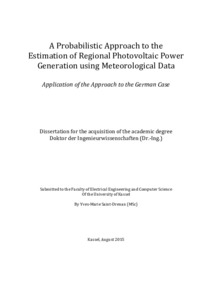A probabilistic approach to the estimation of regional photovoltaic power generation using meteorological data
| dc.date.accessioned | 2016-09-05T12:21:06Z | |
| dc.date.available | 2016-09-05T12:21:06Z | |
| dc.date.issued | 2016-09-05 | |
| dc.identifier.uri | urn:nbn:de:hebis:34-2016090550868 | |
| dc.identifier.uri | http://hdl.handle.net/123456789/2016090550868 | |
| dc.language.iso | eng | |
| dc.rights | Urheberrechtlich geschützt | |
| dc.rights.uri | https://rightsstatements.org/page/InC/1.0/ | |
| dc.subject | Photovoltaik | ger |
| dc.subject | Meteorologie | ger |
| dc.subject.ddc | 620 | |
| dc.title | A probabilistic approach to the estimation of regional photovoltaic power generation using meteorological data | eng |
| dc.type | Dissertation | |
| dcterms.abstract | In Germany the upscaling algorithm is currently the standard approach for evaluating the PV power produced in a region. This method involves spatially interpolating the normalized power of a set of reference PV plants to estimate the power production by another set of unknown plants. As little information on the performances of this method could be found in the literature, the first goal of this thesis is to conduct an analysis of the uncertainty associated to this method. It was found that this method can lead to large errors when the set of reference plants has different characteristics or weather conditions than the set of unknown plants and when the set of reference plants is small. Based on these preliminary findings, an alternative method is proposed for calculating the aggregate power production of a set of PV plants. A probabilistic approach has been chosen by which a power production is calculated at each PV plant from corresponding weather data. The probabilistic approach consists of evaluating the power for each frequently occurring value of the parameters and estimating the most probable value by averaging these power values weighted by their frequency of occurrence. Most frequent parameter sets (e.g. module azimuth and tilt angle) and their frequency of occurrence have been assessed on the basis of a statistical analysis of parameters of approx. 35 000 PV plants. It has been found that the plant parameters are statistically dependent on the size and location of the PV plants. Accordingly, separate statistical values have been assessed for 14 classes of nominal capacity and 95 regions in Germany (two-digit zip-code areas). The performances of the upscaling and probabilistic approaches have been compared on the basis of 15 min power measurements from 715 PV plants provided by the German distribution system operator LEW Verteilnetz. It was found that the error of the probabilistic method is smaller than that of the upscaling method when the number of reference plants is sufficiently large (>100 reference plants in the case study considered in this chapter). When the number of reference plants is limited (<50 reference plants for the considered case study), it was found that the proposed approach provides a noticeable gain in accuracy with respect to the upscaling method. | eng |
| dcterms.accessRights | open access | |
| dcterms.alternative | Application of the approach to the German case | eng |
| dcterms.creator | Saint-Drenan, Yves-Marie | |
| dc.contributor.corporatename | Kassel, Universität Kassel, Fachbereich Elektrotechnik / Informatik | |
| dc.contributor.referee | Braun, Martin (Prof. Dr.-Ing.) | |
| dc.contributor.referee | Wald, Lucien (Prof. Dr.) | |
| dc.subject.swd | Fotovoltaik | ger |
| dc.subject.swd | Meteorologie | ger |
| dc.date.examination | 2016-02-05 |
Dateien zu dieser Ressource
Das Dokument erscheint in:
-
Dissertationen [1]

